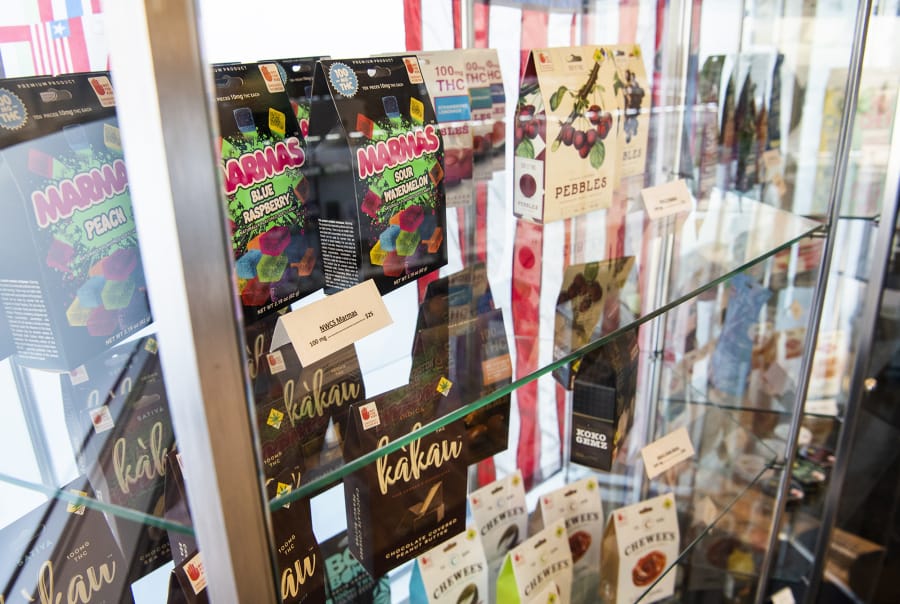Spokane — State regulators have resolved some of the rancor that followed the announcement late last year that certain types of cannabis-infused candy would be taken off store shelves.
The Washington Liquor and Cannabis Board approved new regulations on packaging and labeling marijuana products earlier this month that the agency says are intended to keep them out of the hands of children.
While the new rules prohibit marijuana products featuring “a name, design or brand” that is similar to something you’d see in a candy or toy shop, they aren’t as sweeping as the emergency ban swiftly approved last year, said Chris Marr, a former state legislator who is now a consultant for the new industry.
“That actually caused one of the biggest uproars in the licensee community, the marijuana producers and retailers, that I can really recall in the past six years,” Marr said of last year’s ban.
Because of that backlash, the board adopted several interim policies at the end of 2018 while they spoke to cannabis businesses, drug prevention groups and others to develop the new rules. Those rules were rescinded and replaced with permanent guidelines that the board believes are a better approach to solving the issue of children accessing the drug.
“We have a certain period of time that’s mandated by law, that allows people to throw their best thinking my way, how they’d like to see those rules change,” said Kathy Hoffman, the rules coordinator for cannabis at the Liquor and Cannabis Board.
Hoffman came to the LCB by way of the Washington Health Department, where regulators already were talking with multiple stakeholders before implementing a rule, she said. Hoffman brought that approach to the LCB in developing the packaging standards, earning praise from Marr and others in the industry.
The regulatory body also was guided by a state law, passed earlier this year, requiring the board to develop new packaging and labeling standards while at the same time giving companies more room to promote the effects of their products on the body.
The result to the casual cannabis consumer likely will be minimal, Marr said. But for those in the industry, the process showed that state regulators could work with cannabis businesses to come up with a plan for regulating marijuana packaging that made sense for everyone.
“It was a watershed moment for the LCB in terms of them saying, this is very complicated, and it’s going to have all kinds of ripple effects through the supply chain,” Marr said.
One of those concessions was giving the businesses more time to comply with the new standards, which also include standardized messages about the risk posed to children and pregnant women. The weights of the products also will now be reported in ounces, not just grams, which brings Washington-sold cannabis more in line with other standardized dry goods sold across state lines, said Crystal Oliver, a Deer Park-based producer who is the executive director of the Washington Sungrowers Industry Association, which represents the interests of small, outdoor cannabis farmers statewide.
“With some of these packaging and labeling changes, I think we’ll have greater success come federal legalization,” Oliver said.
The Liquor and Cannabis Board will give producers and processors until July 1 to produce packaging that complies with the new rules. Retailers will have until the end of the year to sell all those products, with a final switchover deadline of Jan. 1, 2021.
Though the board spoke with both drug prevention and industry advocates before passing the new rules, there still are concerns with the final product. Multiple groups sent letters to the Liquor and Cannabis Board earlier this month, citing concerns about the new plastic standard that will halve the thickness of packaging for edibles. The change was requested by the industry to reduce waste.
“Making packages thinner, and therefore easier to open, does not benefit anyone when considered against keeping infants, toddlers, or preschoolers from consuming a misplaced cannabis purchase,” wrote a representative of the Washington Association for Substance Abuse and Violence Prevention, in a Dec. 11 email to the board.
Hoffman acknowledged that some in the prevention community would prefer the greater thickness standard. The new, approved packaging will be similar in thickness to beef jerky, she said, whereas the thicker standard would have required packaging similar to what a new mattress is shipped in.
Industry representatives said that while the new packaging rules allow some room for displaying the particular product’s effect on health, that freedom was largely hemmed in by efforts in the state Legislature. Any claims made on the packaging must adhere to federal rules that prohibit “false or misleading” claims, per the state law, and require some substantiation from research.



